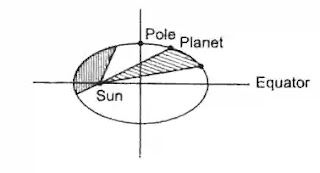Ad Code
Categories
Most Popular
Gravitation | Physics, Definition, Types, laws, facts, formulas, |
Gravitation is one of four classes found in nature. These are, The Gravitational Force, The Electromagnetic Force, The Strong Nuclear Force and The Weak Nuclear Force. It is gravity that holds the universe together. In this, we shall learn the basic laws that govern gravitational interactions.
⇐ Click here buy now and more information this Book.
Universal Law of Gravitation
Every object in the universe attracts every other object with a force that is proportional to the product of their masses and inversely proportional to the square of the distance between them. The force is along the line joining the centers of two objects. This whole phenomenon is gravitation. It is also known as Newton's law of gravitation.
Thus, F ∝ 1/d²
and F ∝ M × m
⇒ F = G M×m / d²
Here G is the proportional constant and is called the universal gravitational constant. Its SI unit is Nm² kg-² and value is 6.673 × 10-¹¹
The value of G was found out by Henry Cavendish.
Free Fall
When an object falls towards the earth under the force of gravity alone, that object falls freely.
In a free fall, we observe that the direction of the motion doesn't change but there is a change in magnitude of the velocity
Acceleration Due to Gravity
When a body falls freely, then the increase in its velocity per second is called acceleration due to gravity. It is represented by g.
g = GMe/R²e
Where, Me = mass of Earth
Re = radius of Earth.
Change In Value of 'g'
1. The value of 'g' is minimum at equator and maximum at poles (It happens due to non-spherical shape of the Earth).
2. The observed value of 'g' at the lattitude 'λ' is
gλ = g - Re ω² cos² λ
At equator, gλ = g - Re ω²
Al pole, gλ = g
3. Value of 'g' at height 'h' above Earth surface decreases.
g' = g/[1 + h/Re]² = g[1 - 2h/Re]
4. Value of 'g' at height 'h' below Earth's surface decreases.
g' = g [1 - h/Re]
Motion of Objects Under the Influence of Gravitational Force of the Earth
Since 'g' is constant near the Earth, all equations for uniformly accelerated motion of objects become valid when the acceleration 'a' is replaced by g.
Thus, equations are
v = u ± gt
s = u ± 1/2 gt²
v² = u² ± 2gs
Planet
The celestial bodies that revolve around the Sun are called planets, e.g., Earth.
Satellite
Those celestial bodies that revolve around the planets, such as satellites, are called moons.
These are of two types
- Natural Satellite
- Artificial satellite
Escape Velocity
The minimum velocity that should be given to the body to enable it to escape away from Earth's gravitational field is called escape velocity (ves).
ves = √2GM/√Re = √2gRe
Its value for Earth's surface is 11.2km/s.
Kepler's Law
- The planet moves in an elliptical path while the Sun is at one of its focus.
- L The radius vector sweeps through the same area in equal time intervals.
- The square time period of the planet is equal to the cube of the length of the semi-major axis.
Important Tips
- The gravitational force between two masses is independent of the presence of other objects and medium between the two masses.
- The value of escape velocity of a body does not depend on its mass.
- The escape velocity of a body depends on the radius of planet from which it is projected.
- The value of escape velocity does not depend on the angle and direction of projection.
- For Earth Re 6400 km. g = 9.8 m/s².
- Orbital speed of a satellite near the surface of Earth vo = √6.4 × 10⁶ × 9.8 = 8 km/s.
- Weight of an object on Moon= (1/6) × its weight on the Earth.
Related Questions : (Answer in comment box.)
Q1. If ve denotes escape velocity and vo denotes orbital velocity of a satellite revolving around a planet of radius R, then
(a) ve = √2•vo
(b) ve = 2vo
(C) 2ve = vo
(d) √2•ve = vo
Q2. 1f R denotes the radius of orbit of a satellite of mass m revolving around a planet of mass M the sqiared orbital velocity of the satellite is given by
(a) vo² = GM/R
(b) vo² =GmM/R
(c) vo² = GR/M
(d) vo² = GM/mR
Q3. The escape velocity of a sphere of mass m from the earth having mass M and radius R is given by
(a) √2GM/√R
(b) √2GmM/√R
(c) 2√GM/√R
(d) √GM/√R
Q4. The weight of a body at the centre of the earth is
(a) same as on surtace of Earth
(b) half of that on surface
(c) infinite
(d) zero
Q5. There is no atmosphere on moon because
(a) it is closer to Earth
(b) It revolves round the Earth
(c) it gets light from the Sun
(d) the escape velocity of gas molecule is smaller than their rms velocity
Q6. If the earth is at one-fourth of its present distance from the sun, the duration of the year will be
(a) one-half the present year
(b) one-sixth the present year
(c) one-eighth the present year
(d) one-fourth the present year
Q7. If the earth stops rotating, the value of g at the equator will
(a) remain same
(c) decrease to quarter
(b) rermain half
(d) increase
|Gravitation|Physics, Definition, Types, laws, facts, formulas|
If you have any doubts let me know in comment box.
Thank you,



1 Comments
☺☺☺☺☺
ReplyDeleteIf you have any doubts let me know.